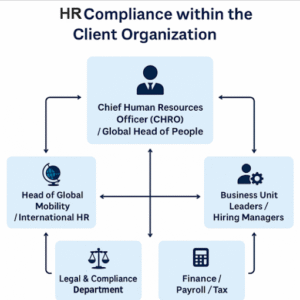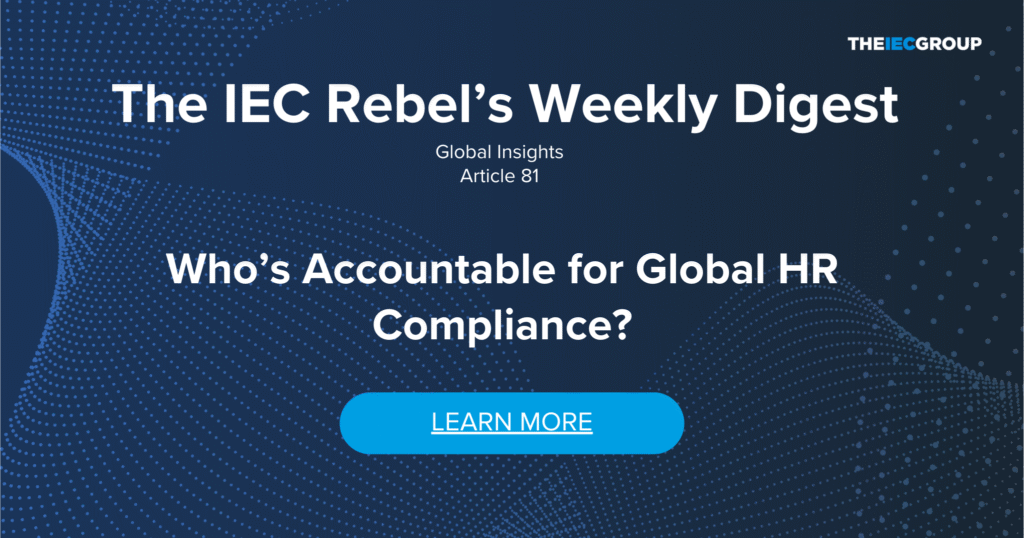Who’s Accountable for Global HR Compliance?
Executive Summary
 “Our people are our most important asset.”
“Our people are our most important asset.”
Every CEO says it. But few companies can answer a more difficult question: Who is accountable for their legal protection across 20, 30, or 50 countries?
As global hiring accelerates, compliance complexity multiplies. Tax, benefits, labor laws, social security, onboarding, health and safety—all vary dramatically by jurisdiction. And yet, in many organizations, nobody owns global people compliance end-to-end.
The HR team handles hiring. Legal reviews contracts. Finance processes payroll. But compliance? It often falls between the cracks.
And when it does, the risk isn’t theoretical. It’s real—co-employment liabilities, permanent establishment exposure, legal penalties, or blocked market access.
This article from IEC Rebel’s Digest is a wake-up call:
- Why workforce compliance must be treated as a strategic infrastructure
- Who inside your company is legally and operationally on the hook
- What defines a trustworthy EOR—and how to verify it
- Why accountability frameworks must be established before risk escalates
[Read the full article →]
Introduction: Are People Really Your Most Valuable Resource?
Every CEO will say yes. Every investor will nod in agreement. Every annual report will have the same headline: “Our people are our most important asset.” But in the day-to-day execution of global expansion, those “assets” are too often left unprotected, unmanaged, or improperly classified.
In a world where global hiring is frictionless, but compliance is not, companies must ask themselves: Who actually owns workforce compliance across borders? And more importantly: Is anyone building the infrastructure to hire globally in a way that’s legally sound, efficient, and scalable?
Global Talent, Local Laws: The Compliance Conundrum
Hiring in Germany is not the same as hiring in Brazil, or India, or Mexico. Each jurisdiction comes with its own regulatory DNA: labor leasing laws, tax frameworks, employee protections, works councils, language requirements, and termination restrictions. The legal exposure from getting it wrong can be catastrophic.
Yet, as more companies go global, many forget that scaling fast without scaling compliance is a risk strategy, not a growth strategy.
The problem? Nobody knows who owns it.
- The HR team is focused on recruitment and onboarding.
- The Legal department may not have jurisdiction-specific labor law knowledge.
- The Finance team is looking at total cost of employment.
- Operations just want people in seats, fast.
And somewhere in the middle, compliance falls through the cracks.
Who Should Own Global Workforce Compliance?
In most organizations, there is no Chief Compliance Officer for People. But maybe there should be. Because workforce compliance is more than just payroll tax and employment contracts.
It includes:
- Employee classification (contractor vs. employee)
- Social security and statutory benefits
- Data protection and onboarding procedures
- Labor leasing licenses and employment permits
- Health and safety obligations
- Works council or union obligations
And when you’re operating across 10, 20, or 50 countries, managing these without central ownership leads to fragmented processes, inconsistent risk exposure, and the very real threat of permanent establishment or labor disputes.
Emerging Best Practice: People Compliance as Shared Ownership
Some leading companies are embedding workforce compliance into cross-functional teams:
- HR owns employee experience and onboarding.
- Legal owns employment classification and contracts.
- Finance owns payroll compliance and reporting.
- Risk or Audit teams monitor ongoing compliance health.
But even this model has limitations if there’s no central infrastructure to operationalize it.
Why Infrastructure Is the New HR Strategy
Compliance doesn’t scale manually. For every new market entered, you need local expertise, local systems, and local processes. That’s where Employer of Record (EOR) services entered the conversation.
EORs: The Shortcut or the Solution?
EOR platforms promise fast entry into global markets without having to set up a local entity. They become the legal employer of your talent and take care of compliance, payroll, benefits, and documentation.
But here’s the catch: Not all EORs are created equal.
And just because an EOR says they’re compliant, doesn’t mean they’re independently verified.
That’s why the IEC Group developed the EOR Compliance Audit Program.
For HR and Legal leaders evaluating providers, the message is clear: Look for proof, not promises.
Building Internal Readiness: What Companies Must Do
Even with a certified EOR, companies must ensure they:
- Have internal policies aligned with international standards
- Know who is responsible for what (client vs. EOR vs. local partner)
- Track global headcounts and employment models
- Conduct regular audits or reviews of classification and benefits
Global compliance isn’t a plug-and-play tool. It’s a mindset and a system.
Companies expanding globally need to build a people compliance stack—the combination of:
- Trusted partners (EORs, payroll providers)
- Legal frameworks
- Internal documentation
- Process governance
- External Audits
Only then can you truly say your people are your most important asset—and prove it.
Within the client’s organization, the responsibility and potential liability for EOR-related compliance is typically shared — but someone must ultimately be accountable. Here’s how it breaks down:
Who’s Ultimately Responsible Within the Client Company?
- Chief Human Resources Officer (CHRO) or Global Head of People
- Primary accountability for workforce compliance.
- Expected to ensure that all hiring — including via EOR — is aligned with labor laws, policies, and risk thresholds.
- Must understand what compliance is outsourced vs. retained internally.
- Often the one who signs off on global employment decisions and EOR vendor selections.
- Head of Global Mobility / International HR
- Operational responsibility for compliance in cross-border hiring.
- Coordinates with EOR providers and legal teams.
- Manages employment documentation, onboarding, and local labor requirements.
- Legal & Compliance Department
- Shared liability and advisory role.
- Reviews EOR agreements, data protection clauses, indemnities, and regulatory exposure.
- Must ensure the company is not violating permanent establishment rules or co-employment risks.
- Finance / Payroll / Tax
- May bear responsibility for tax compliance, shadow payroll, and global compensation reporting.
- Responsible for budget approvals and vendor payments.
- Business Unit Leaders / Hiring Managers
- May inadvertently create compliance risks by hiring talent in countries without informing HR or legal.
- Can be held responsible if they bypass process or use “unofficial” workarounds.
✅ Bottom Line:
The CHRO or Head of HR is ultimately accountable, but compliance is a cross-functional responsibility across HR, Legal, Finance, and Operations.
If no clear owner is defined, everyone is at risk — and no one is protected.
IEC Rebel’s Digest— The IEC Group can help you audit your global employment setup by identifying labor leasing risks, verifying licensing requirements, and ensuring your EOR partners meet every compliance standard—before regulators come knocking.
Last but not Least: If you’re facing challenges and wondering how others are managing similar issues, why not join The Leadership Collective Community? It’s a peer group and webcast platform designed for leaders to exchange insights and experiences.
Introducing the IEC Knowledge Network Free Membership – Your Gateway to Seamless Access!
We are thrilled to present a new service that goes beyond the ordinary download experience. In addition to offering you the ability to download the things you love, we are delighted to introduce the IEC Knowledge Network Free Membership.
The Free Membership option grants you access to our library of articles and videos, without the need for tedious registrations for each piece of content.
The publication serves as a trusted resource to support executives in their pursuit of sustainable and successful global expansion. In addition the IEC Practitioners are available to discuss your specific challenge in more detail and to give you clear advise..
Take advantage of this valuable resource to accelerate your global expansion journey


